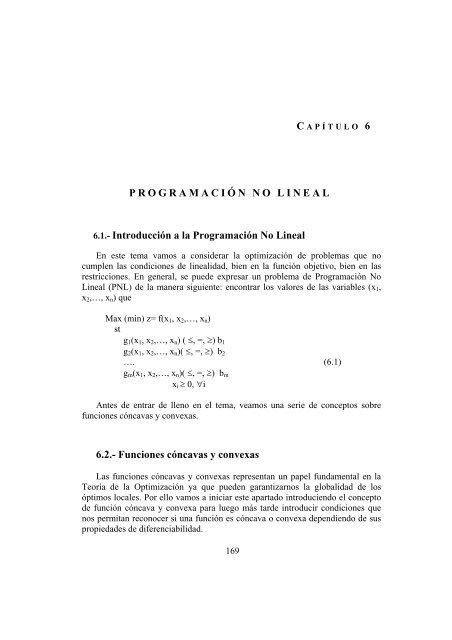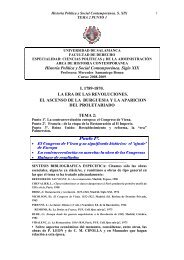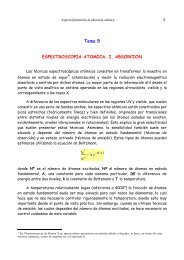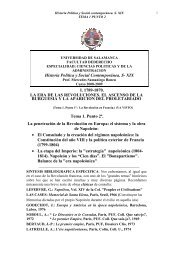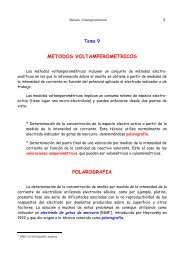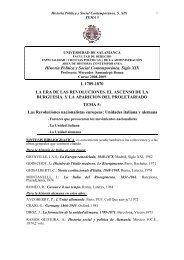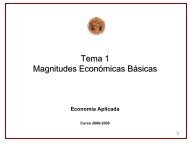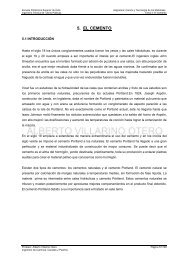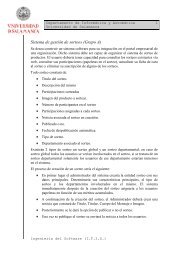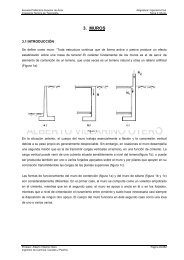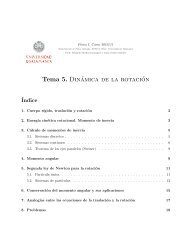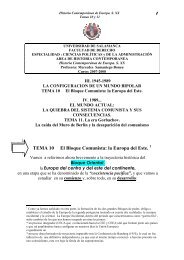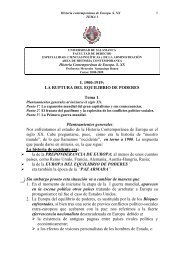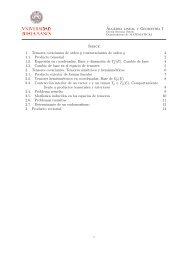TEMA 6. Programación No Lineal. Métodos de ... - OCW Usal
TEMA 6. Programación No Lineal. Métodos de ... - OCW Usal
TEMA 6. Programación No Lineal. Métodos de ... - OCW Usal
You also want an ePaper? Increase the reach of your titles
YUMPU automatically turns print PDFs into web optimized ePapers that Google loves.
PROGRAMACIÓN NO LINEAL<br />
<strong>6.</strong>1.- Introducción a la <strong>Programación</strong> <strong>No</strong> <strong>Lineal</strong><br />
169<br />
C APÍTULO 6<br />
En este tema vamos a consi<strong>de</strong>rar la optimización <strong>de</strong> problemas que no<br />
cumplen las condiciones <strong>de</strong> linealidad, bien en la función objetivo, bien en las<br />
restricciones. En general, se pue<strong>de</strong> expresar un problema <strong>de</strong> <strong>Programación</strong> <strong>No</strong><br />
<strong>Lineal</strong> (PNL) <strong>de</strong> la manera siguiente: encontrar los valores <strong>de</strong> las variables (x1,<br />
x2,…, xn) que<br />
Max (min) z= f(x1, x2,…, xn)<br />
st<br />
g1(x1, x2,…, xn) ( , =, ) b1<br />
g2(x1, x2,…, xn)( , =, ) b2<br />
…. (<strong>6.</strong>1)<br />
gm(x1, x2,…, xn)( , =, ) bm<br />
xi 0, i<br />
Antes <strong>de</strong> entrar <strong>de</strong> lleno en el tema, veamos una serie <strong>de</strong> conceptos sobre<br />
funciones cóncavas y convexas.<br />
<strong>6.</strong>2.- Funciones cóncavas y convexas<br />
Las funciones cóncavas y convexas representan un papel fundamental en la<br />
Teoría <strong>de</strong> la Optimización ya que pue<strong>de</strong>n garantizarnos la globalidad <strong>de</strong> los<br />
óptimos locales. Por ello vamos a iniciar este apartado introduciendo el concepto<br />
<strong>de</strong> función cóncava y convexa para luego más tar<strong>de</strong> introducir condiciones que<br />
nos permitan reconocer si una función es cóncava o convexa <strong>de</strong>pendiendo <strong>de</strong> sus<br />
propieda<strong>de</strong>s <strong>de</strong> diferenciabilidad.
170 Investigación Operativa<br />
Definición <strong>6.</strong>1. Diremos que una función f(x) es estrictamente cóncava en un<br />
conjunto S convexo si todo segmento que une dos puntos <strong>de</strong> la gráfica esta<br />
estrictamente por <strong>de</strong>bajo <strong>de</strong> la gráfica.<br />
Definición <strong>6.</strong>2. Diremos que una función es cóncava (no estricta) si no todas<br />
las cuerdas que unen puntos <strong>de</strong> la gráfica en dicho intervalo quedan estrictamente<br />
por <strong>de</strong>bajo.<br />
Definición <strong>6.</strong>3. Sea f(x) una función <strong>de</strong>finida en un intervalo <strong>de</strong> R, diremos<br />
que dicha función es convexa en el intervalo si todo segmento que une dos puntos<br />
<strong>de</strong> la gráfica queda por encima <strong>de</strong> la gráfica. Si siempre queda estrictamente por<br />
encima, <strong>de</strong>cimos que la función es estrictamente convexa.<br />
Definición <strong>6.</strong>4. Sea S un subconjunto convexo <strong>de</strong> R n y sea f: S R. Diremos<br />
que f(x) es una función convexa en S si para cualquier par <strong>de</strong> puntos x, yS y<br />
para cualquier b[0,1]<br />
f[(1-b)x+by] (1-b)f(x)+bf(y)<br />
Definición <strong>6.</strong>5. f(x) es una función estrictamente convexa en S si para<br />
cualquier par <strong>de</strong> puntos x, yS y para cualquier b[0,1]<br />
f[(1-b)x+by] < (1-b)f(x)+bf(y)<br />
En la figura siguiente se representa gráficamente una función convexa:<br />
Definición <strong>6.</strong><strong>6.</strong> f(x) es una función cóncava en S si para cualquier par <strong>de</strong><br />
puntos x, yS y para cualquier b[0,1]<br />
f[(1-b)x+by] (1-b)f(x)+bf(y)
<strong>Programación</strong> no <strong>Lineal</strong> 171<br />
Definición <strong>6.</strong>7. f(x) es una función estrictamente cóncava en S si para<br />
cualquier par <strong>de</strong> puntos x, yS y para cualquier b[0,1]<br />
f[(1-b)x+by] > (1-b)f(x)+bf(y)<br />
En la figura siguiente se representa gráficamente una función cóncava:<br />
Ejercicio <strong>6.</strong>1. Demostrar por <strong>de</strong>finición que f(x)=x 2 es estrictamente convexa<br />
en R.<br />
Para hacer esta <strong>de</strong>mostración, consi<strong>de</strong>remos dos puntos cualesquiera <strong>de</strong> R,<br />
por ejemplo x1,x2 . Tenemos que <strong>de</strong>mostrar que<br />
y comparar con<br />
f((1-b )x1+ b x2) (1- b )f(x1)+ b f(x2)<br />
((1- b )x1+ b x2) 2 =(1- b ) 2 x1 2 + b 2 x2 2 +2(1- b)bx1x2<br />
(1- b )x1 2 + b x2 2<br />
Obsérvese que no es fácil <strong>de</strong>mostrar la concavidad o convexidad <strong>de</strong> una<br />
función por <strong>de</strong>finición. Por ello es necesario o conveniente disponer <strong>de</strong> unas<br />
condiciones necesarias y suficientes que nos permitan <strong>de</strong>terminar si una función<br />
es cóncava o convexa estudiando otros elementos más operativos.<br />
Propiedad <strong>6.</strong>1. Si f es cóncava en S, entonces -f es convexa en S y si f es<br />
convexa en S, entonces -f es cóncava en S.
172 Investigación Operativa<br />
Propiedad <strong>6.</strong>2. Si f es estrictamente convexa en S, entonces -f es<br />
estrictamente cóncava en S y, si f es estrictamente cóncava en S, entonces -f es<br />
estrictamente convexa en S .<br />
Propiedad <strong>6.</strong>3. Si fi, i=1,..., n son convexas en S, entonces con i 0<br />
es convexa en S. Del mismo modo, si fi, i=1,...,n son cóncavas en S,<br />
n<br />
<br />
i1<br />
entonces con i 0 es cóncava en S.<br />
i fi<br />
Demostración.<br />
Demostramos sólo la primera: Si fi es convexa en S para todo i, entonces para<br />
cualquier par <strong>de</strong> puntos x, yS y para cualquier b[0,1]<br />
fi[(1-b)x+by] (1-b)fi (x)+bfi (y)<br />
Esto quiere <strong>de</strong>cir que para cualquier i >0<br />
entonces<br />
i fi [(1-b)x+by] i ((1-b)f i (x)+bf i (y))<br />
n<br />
<br />
i1<br />
y esto último es cierto si y sólo si<br />
n<br />
<br />
i1<br />
<br />
n<br />
i1<br />
( 1 b)<br />
x by<br />
) ( ( 1<br />
b)<br />
f ( x)<br />
bf ( y))<br />
i fi ( i<br />
i<br />
i<br />
n<br />
i1<br />
i fi ( ( 1<br />
b)<br />
x by<br />
) ( 1<br />
b)<br />
<br />
i fi<br />
( x)<br />
b<br />
i fi<br />
( y)<br />
con lo que queda <strong>de</strong>mostrado que es convexa.<br />
Propiedad <strong>6.</strong>4. El producto <strong>de</strong> funciones cóncavas (convexas) no ha <strong>de</strong> ser<br />
necesariamente una función cóncava (convexa).<br />
Teorema <strong>6.</strong>1. Sea S un subconjunto convexo <strong>de</strong> R n , sea f:S R. Entonces:<br />
a) Si f es convexa en S para todo R, se verifica que el conjunto<br />
n<br />
i1<br />
A={xS / f(x) } es un conjunto convexo.<br />
n<br />
i1<br />
i fi
<strong>Programación</strong> no <strong>Lineal</strong> 173<br />
b) Si f es cóncava en S para todo R se verifica que el conjunto<br />
B={xS / f(x) } es un conjunto convexo.<br />
Demostración.<br />
a) Consi<strong>de</strong>remos un número real cualquiera. Como f es convexa en un<br />
conjunto S (convexo <strong>de</strong> R n ), vamos a <strong>de</strong>mostrar que el conjunto es convexo.<br />
Consi<strong>de</strong>remos dos puntos cualesquiera x, y y sea un b[0,1]<br />
Como dichos puntos son <strong>de</strong>l conjunto , entonces verifican que<br />
f(x) f(y) pues x, y<br />
Como a<strong>de</strong>más f es convexa se verifica que<br />
f[(1-b)x+by] (1-b)f(x)+bf(y) (1-b) b <br />
luego se cumple que b[0, 1] y x, yf[(1-b)x+by] , por tanto el<br />
conjunto es convexo.<br />
b) Se <strong>de</strong>muestra <strong>de</strong> forma análoga.<br />
Propiedad <strong>6.</strong>5. Región factible para un problema <strong>de</strong> PNL es el conjunto <strong>de</strong><br />
valores x=(x1, x2,…, xn) que satisfacen las restricciones <strong>de</strong> (<strong>6.</strong>1).<br />
Propiedad <strong>6.</strong><strong>6.</strong> Máximo local: sea S un conjunto convexo tal que x1, x2S,<br />
f(x1) f(x2) x2 x1 sería un máximo local.<br />
Propiedad <strong>6.</strong>7. Mínimo local: sea S un conjunto convexo tal que x1, x2S, tal<br />
que f(x1) f(x2) x2 x1 sería un mínimo local.<br />
Propiedad <strong>6.</strong>8. Sea el problema Maximización <strong>de</strong> z en un problema <strong>de</strong><br />
programación no lineal (PNL). Si para todo x existe x’ tal que f(x’) f(x), x’<br />
sería la solución óptima (cumpliendo la Propiedad <strong>6.</strong>6).<br />
Propiedad <strong>6.</strong>9. Sea el problema Minimización <strong>de</strong> z en un problema <strong>de</strong><br />
programación no lineal (PNL). Si para todo x existe x’ tal que f(x’) f(x), sería la<br />
solución óptima (cumpliendo la Propiedad <strong>6.</strong>7).
174 Investigación Operativa<br />
Teorema <strong>6.</strong>2. Consi<strong>de</strong>remos un PNL <strong>de</strong> maximización. Supóngase que la<br />
región factible, S, para el PNL es un conjunto convexo. Si f(x) es cóncava sobre<br />
S, entonces cualquier máximo local <strong>de</strong> PNL es una solución óptima para el<br />
problema <strong>de</strong> PNL.<br />
Demostración<br />
Supongamos que existe x que es máximo local y que no es solución óptima,<br />
es <strong>de</strong>cir, x / f(x) > f ( x ).<br />
Po<strong>de</strong>mos formar combinación lineal: f( x + (1- ) x) f( x ) + (1-) f(x)<br />
Como f(x) > f ( x ), tenemos<br />
f( x + (1- ) x) f(x) + (1-) f(x) > f( x ) + (1-) f( x )= f( x )<br />
Po<strong>de</strong>mos tomar 1 x + (1-)x x no pue<strong>de</strong> ser un máximo local, en<br />
contra <strong>de</strong> la hipótesis inicial. Luego, llegamos a una contradicción, por lo que el<br />
teorema es cierto. Es <strong>de</strong>cir, si es máximo local, entonces es una solución óptima<br />
para el PNL.<br />
Definición <strong>6.</strong>8. La matriz Hessiana asociada a una función f(x)= (x1, x2,…,<br />
xn) es una matriz cuadrada, H n x n, tal que sus elementos hij son <strong>de</strong> la forma:<br />
hi j =<br />
z<br />
x<br />
2<br />
i x j<br />
Definición <strong>6.</strong>9. Denominamos Hessiano al <strong>de</strong>terminante asociado a la matriz<br />
Hessiana. En 2 , el hessiano es H: 2 <br />
2<br />
z<br />
2<br />
x1<br />
H = 2<br />
z<br />
x<br />
x<br />
1<br />
2<br />
2<br />
z<br />
x1x<br />
2<br />
z<br />
x<br />
2<br />
2<br />
2<br />
Para un problema <strong>de</strong> Maximización con dos variables, las condiciones que se<br />
han <strong>de</strong> verificar son:<br />
z<br />
= 0,<br />
x1<br />
2<br />
z<br />
< 0 2<br />
x1<br />
z<br />
x<br />
= 0, H( x ) > 0<br />
2
<strong>Programación</strong> no <strong>Lineal</strong> 175<br />
don<strong>de</strong> x es el punto <strong>de</strong> estudio correspondiente al máximo.<br />
Para un problema <strong>de</strong> Minimización con dos variables, las condiciones que se<br />
han <strong>de</strong> verificar son:<br />
2<br />
z z<br />
= 0, > 0 2<br />
x1<br />
x1<br />
z z = 0, H( x ) > 0<br />
x2<br />
don<strong>de</strong> x es el punto <strong>de</strong> estudio correspondiente al mínimo.<br />
Definición <strong>6.</strong>10. El menor principal <strong>de</strong> or<strong>de</strong>n i <strong>de</strong> una matriz Hnxn es el<br />
<strong>de</strong>terminante <strong>de</strong> cualquier matriz ixi que se obtiene al suprimir las n-i filas y las<br />
n-i columnas correspondientes <strong>de</strong> la matriz.<br />
Definición <strong>6.</strong>11. El menor principal dominante <strong>de</strong> or<strong>de</strong>n i <strong>de</strong> una matriz Hnxn<br />
es el <strong>de</strong>terminante <strong>de</strong> cualquier matriz ixi que se obtiene al suprimir las n-i<br />
últimas filas y columnas <strong>de</strong> la matriz.<br />
Teorema <strong>6.</strong>3. Sea la función f(x) con <strong>de</strong>rivadas parciales <strong>de</strong> segundo or<strong>de</strong>n<br />
continuas para cada punto <strong>de</strong> xS (conjunto convexo <strong>de</strong> soluciones factibles).<br />
Entonces f(x) es convexa sobre S si y sólo si, para cada xS, todos los menores<br />
principales, Hi, son no negativos.<br />
Teorema <strong>6.</strong>4. Sea la función f(x) con <strong>de</strong>rivadas parciales <strong>de</strong> segundo or<strong>de</strong>n<br />
continuas para cada punto xS (conjunto convexo <strong>de</strong> soluciones factibles).<br />
Entonces f(x) es cóncava sobre S si y sólo si, para cada xS, los menores<br />
principales, Hi, no nulos tienen el signo que (-1) i .<br />
<strong>6.</strong>3. Optimización sin restricciones en R n<br />
Estudiaremos cómo obtener una solución óptima (si existe) o un extremo<br />
local para el siguiente problema <strong>de</strong> PNL:<br />
Max (min) z = f(x1, x2,…, xn)<br />
st<br />
x = (x1, x2,…, xn), xR n (<strong>6.</strong>2)
176 Investigación Operativa<br />
Supongamos que existen las primeras y las segundas <strong>de</strong>rivadas parciales <strong>de</strong><br />
f(x) y que son continuas en todos los puntos.<br />
Una condición necesaria para que un punto x sea un extremo local para el<br />
PNL (<strong>6.</strong>2) nos la proporciona el teorema siguiente:<br />
Teorema <strong>6.</strong>5. Si x =( x 1 , x2,...,<br />
xn<br />
) es un extremo local para (<strong>6.</strong>2), entonces<br />
f ( x)<br />
= 0, i.<br />
xi<br />
f ( x)<br />
Definición <strong>6.</strong>12. Un punto x que satisfaga = 0 es punto estacionario<br />
xi<br />
<strong>de</strong> la función f(x).<br />
Teorema <strong>6.</strong><strong>6.</strong> Si Hi ( x ) > 0, (i=1, 2, ..., n), entonces un punto estacionario x<br />
será un mínimo local para (<strong>6.</strong>2).<br />
Teorema <strong>6.</strong>7. Si Hi( x )0 (i=1, 2, ..., n) y tiene el signo que (-1) k , entonces<br />
un punto estacionario x será un maximo local para (<strong>6.</strong>2).<br />
Teorema <strong>6.</strong>8. Si Hi( x )0 (i=1, 2, ..., n) y no se dan ninguno <strong>de</strong> los casos<br />
anteriores (teoremas <strong>6.</strong>6 y <strong>6.</strong>7), f(x) presenta un punto <strong>de</strong> inflexión en ese punto<br />
x .<br />
Ejercicio <strong>6.</strong>2. Obtener el extremo <strong>de</strong> z = x1+2x3 + x2 x3 - x1 2 - x2 2 - x3 2<br />
La condición necesaria para que exista extremo es:<br />
z<br />
x<br />
= 1- 2 x1 = 0,<br />
1<br />
z<br />
x<br />
= 1 x3 - 2 x2 =0,<br />
2<br />
z<br />
x<br />
= 2 + x2 - 2 x3 = 0<br />
3<br />
z<br />
= 0, para i=1, 2, 3.<br />
x<br />
Resolviendo el sistema anterior, obtenemos, para el extremo, el punto objeto<br />
<strong>de</strong> estudio ( 1/2, 2/3, 4/3 ) = x0<br />
Condición suficiente:<br />
i
H =<br />
2 z<br />
2<br />
x1<br />
2<br />
z<br />
<br />
x2x<br />
2 z<br />
<br />
x3x<br />
1<br />
1<br />
2<br />
z<br />
x1x<br />
2<br />
z<br />
2<br />
x2<br />
2<br />
z<br />
x<br />
x<br />
Estudio <strong>de</strong> los menores principales:<br />
Or<strong>de</strong>n 1:<br />
3<br />
<strong>Programación</strong> no <strong>Lineal</strong> 177<br />
2<br />
2<br />
2<br />
z<br />
x1x<br />
2<br />
z<br />
x2x<br />
2<br />
z<br />
2<br />
x<br />
| H1x1 | = -2 < 0 signo (-1) 1<br />
Or<strong>de</strong>n 2:<br />
| H2x2 | =<br />
Or<strong>de</strong>n 3:<br />
| H3x3 | =<br />
2<br />
0<br />
2<br />
0<br />
0<br />
0<br />
2<br />
0<br />
2<br />
1<br />
3<br />
3<br />
3<br />
<br />
<br />
<br />
<br />
<br />
<br />
<br />
<br />
<br />
=<br />
= 4> 0 signo (-1) 2<br />
0<br />
1<br />
2<br />
2 0 0 <br />
<br />
<br />
0 2 1 <br />
<br />
<br />
0 1 2<br />
= -8+2= -6 < 0 signo (-1) 3<br />
Por tanto, tenemos el signo <strong>de</strong> (-1) i . Así pues, en el punto x0, tenemos un<br />
posible máximo. Como el valor <strong>de</strong> los menores principales no <strong>de</strong>pen<strong>de</strong> <strong>de</strong>l punto,<br />
en ese punto tenemos un máximo.<br />
<strong>6.</strong>4.- Búsqueda <strong>de</strong> la sección Áurea<br />
Consi<strong>de</strong>remos una función f(x) para la cual la <strong>de</strong>rivada <strong>de</strong> f(x), f’(x), es difícil<br />
<strong>de</strong> obtener o no existe. El problema <strong>de</strong> PNL a resolver es<br />
Max z = f(x)<br />
st a x b (<strong>6.</strong>3)
178 Investigación Operativa<br />
Definición <strong>6.</strong>13. Una función f(x) es unimodal en el intervalo [a,b] si se<br />
verifica que existe un punto x , tal que f(x) es creciente en [a, x ] y <strong>de</strong>creciente<br />
en [ x , b].<br />
En la búsqueda <strong>de</strong> la Sección Áurea, elegimos dos puntos, x1, x2, <strong>de</strong> manera<br />
razonada, <strong>de</strong> forma que podamos estudiar los siguientes casos:<br />
CASO 1: f(x1) < f(x2) CASO 2: f(x1) = f(x2)<br />
a x1 x2 b a x1 x2 b<br />
I = (x1, b] I = [ a, x2) ó I =(x1, b]<br />
CASO 3: f(x1) >f(x2)<br />
a x1 x2 b<br />
I = [ a, x2)<br />
Sección Áurea se <strong>de</strong>nomina al coeficiente r, el cual se <strong>de</strong>termina <strong>de</strong> la<br />
siguiente forma:<br />
1 ( longitud <strong>de</strong> todo el segmento)<br />
=<br />
r ( longitud <strong>de</strong> la parte más l arg a <strong>de</strong>l segmento)<br />
r ( longitud <strong>de</strong> la parte más l arg a <strong>de</strong>l segmento)<br />
=<br />
1<br />
r ( longitud <strong>de</strong> la parte más corta <strong>de</strong>l segmento)<br />
r 2 = 1-r r 2 +r-1=0, r = 0,618
<strong>Programación</strong> no <strong>Lineal</strong> 179<br />
En cada caso, po<strong>de</strong>mos <strong>de</strong>mostrar que la solución óptima para (<strong>6.</strong>1) estará en<br />
un subconjunto [a, b].<br />
La búsqueda <strong>de</strong> la Sección Áurea empieza con la evaluación <strong>de</strong> f(x) en los<br />
puntos x1 y x2, don<strong>de</strong> x1=b-r(b-a) y x2=a+r(b-a).<br />
r(b-a)<br />
x1 x2<br />
a b<br />
r(b-a)<br />
Definiciones <strong>6.</strong>14.<br />
Lk : longitud <strong>de</strong>l intervalo <strong>de</strong> incertidumbre <strong>de</strong>spués <strong>de</strong> realizar k iteraciones.<br />
Ik : intervalo <strong>de</strong> incertidumbre <strong>de</strong>spués <strong>de</strong> realizar k iteraciones.<br />
b - x1 = r(b-a) x1 = b - r(b-a)<br />
x2 - a = r(b-a) x2 = a + r(b-a)<br />
x1 y x2 quedan perfectamente <strong>de</strong>finidos.<br />
L1 = r(b-a)<br />
CASO 1: f(x1) < f(x2)<br />
L1 = r(b-a)<br />
I1 = (x1, b], b - x1= r(b-a), r 2 = 1-r<br />
r(b- x1)<br />
x3 x4<br />
x1 b<br />
r(b- x1)<br />
x3 = b - r(b- x1) = b – r r(b-a) = b - r 2 (b-a)<br />
x3 = b - (1-r) (b-a)= x2<br />
x4 = x1 + r(b- x1) = x1 + r r(b-a) = x1 + r 2 (b-a)<br />
L2 = b - x3 = r(b – x1) = r 2 (b-a), I2 = (x3, b]<br />
Siguiendo el mismo proceso, llegamos a una expresión general para la<br />
longitud <strong>de</strong>l intervalo <strong>de</strong> incertidumbre <strong>de</strong>spués <strong>de</strong> realizadas k iteraciones <strong>de</strong>l<br />
algoritmo:
180 Investigación Operativa<br />
Lk = r k (b-a), r k =<br />
Tomando logaritmos<br />
k log r = log Lk - log (b-a)<br />
k =<br />
log Lk log( b a)<br />
log r<br />
L k<br />
b a<br />
Poniendo la condición <strong>de</strong> que la longitud <strong>de</strong> incertidumbre sea menor o igual<br />
que un valor prefijado, , tenemos que el número <strong>de</strong> iteraciones, k, viene dado por<br />
log log( b a)<br />
Lk k =<br />
log r<br />
El valor que tomamos para k es el entero más próximo por exceso, [k]+1.<br />
CASO 2 : f(x1) f(x2)<br />
L1 = r(b-a)<br />
I1 = [a, x2), x2-a= r(b-a), r 2 = 1-r<br />
r(x2 - a)<br />
x3 x4<br />
a x2<br />
r(x2 - a)<br />
x3 = x2 - r(x2 - a) = x2 - r 2 (b-a)<br />
x4 = a + r (x2-a) = a + r 2 (b-a)<br />
x4 = a + (1-r)(b-a) = a+b-a-r(b-a) = b-r(b-a) = x1<br />
x1 = b - r (b-a)<br />
L2 = x4 - a= r(x3 - a) = r 2 (b-a)<br />
Siguiendo el mismo proceso, llegamos a una expresión general para la<br />
longitud <strong>de</strong>l intervalo <strong>de</strong> incertidumbre <strong>de</strong>spués <strong>de</strong> realizadas k iteraciones <strong>de</strong>l<br />
algoritmo:
Lk = r k (b-a), r k =<br />
<strong>Programación</strong> no <strong>Lineal</strong> 181<br />
L k<br />
b a<br />
log log( b a)<br />
Lk k =<br />
;<br />
log r<br />
El valor que tomamos para k es el entero más próximo por exceso, [k].<br />
CASO 3: f(x1) < f(x2)<br />
Caso 3.1: f(x3) < f(x4)<br />
Caso 3.2: f(x3) f(x4)<br />
Caso 3.1:<br />
f(x1) < f(x2) L1 = r(b-a); I1 = (x1, b]<br />
f(x3) < f(x4)<br />
r(b- x3)<br />
x5 x6<br />
x3 b<br />
L2 = r (b - x1), L2 < L1<br />
I2 = (x3, b]<br />
x5 = b - r (b- x3)<br />
x6 = x3 + r (b- x3)<br />
y así sucesivamente.<br />
Ejemplo: Max z =f(x)<br />
st<br />
-1x1<br />
r(b- x3)<br />
¿Cuánto tiene que valer k para que el error sea 10 –3 ?<br />
3<br />
log10<br />
log2<br />
k =<br />
= 15’79 k=16<br />
log0'618
182 Investigación Operativa<br />
<strong>6.</strong>5.- Método <strong>de</strong>l gradiente<br />
El método <strong>de</strong>l gradiente se aplicará para aproximar un punto estacionario <strong>de</strong><br />
una función cuando sea difícil encontrar ese punto estacionario.<br />
En este apartado, se estudiará cómo obtener una solución óptima (si existe)<br />
para un problema <strong>de</strong> PNL sin restricciones:<br />
Max (min) z = f(x)<br />
st x n<br />
Definición <strong>6.</strong>15. El gradiente es un vector cuyas componentes son <strong>de</strong>rivadas<br />
parciales <strong>de</strong> la función f(x) que queremos estudiar.<br />
f<br />
( x)<br />
f<br />
( x)<br />
f ( x)<br />
f(x) = ( , , …, )<br />
x<br />
x<br />
x<br />
1<br />
f<br />
( x)<br />
El vector normalizado <strong>de</strong>l gradiente es: u =<br />
|| f<br />
( x)<br />
||<br />
2<br />
El gradiente nos proporciona la dirección <strong>de</strong> máximo cambio.<br />
)<br />
x0 x1 ; || f(x1) || < <br />
(x f<br />
Los pasos a seguir son:<br />
i) Fijamos un punto inicial x0 y en la dirección <strong>de</strong>l gradiente, nos<br />
<strong>de</strong>splazamos hasta otro punto x1.<br />
ii) Fijamos el grado <strong>de</strong> aproximación a la solución a través <strong>de</strong> <br />
(||f(x1) ||< ).<br />
iii) Si se cumple la condición, x1 se encontrará cercano a un punto<br />
f ( x)<br />
estacionario ( = 0 ).<br />
x<br />
iv) Si no se cumple, buscaremos <strong>de</strong> forma iterativa un punto xj en el que se<br />
verifique || f(xj) || < .<br />
)<br />
Max z = f(x0 + t0 f(x0)) x0 x1: x1 = x0 + t0 f(x0)<br />
(x f<br />
st t0 0<br />
<strong>No</strong>s preguntamos ¿ es || f(x1) || < ?<br />
Si lo es, hemos terminado.<br />
n
En caso contrario<br />
<strong>Programación</strong> no <strong>Lineal</strong> 183<br />
)<br />
Max z=f(x1 + t1 f(x1)) x1 x2: x2= x1 + t1 f(x1)<br />
(x f<br />
st t1 0<br />
¿ Es || f(x2) || < ?<br />
Si lo es, hemos terminado.<br />
En caso contrario, seguimos con el proceso hasta encontrar un punto que lo<br />
verifique.<br />
El proceso anterior se repite hasta cumplir la condición <strong>de</strong> parada,(||f(xi) ||< ).<br />
Ejercicio <strong>6.</strong>3. Utilizando el método <strong>de</strong>l gradiente aproxime la solución <strong>de</strong><br />
Max z = f (x1, x2) = -(x1-1) 2 - (x2 -2) 2<br />
st (x1, x2) R 2<br />
Para resolverlo elegimos <strong>de</strong> forma arbitraria el punto x0 = (1, 1) y calculamos<br />
el gradiente en ese punto<br />
f<br />
( x)<br />
f<br />
( x)<br />
f(x) = ( , )= (-2(x1-1)-2(x2-2))<br />
x<br />
x<br />
1<br />
2<br />
x1 = x0 + t0 f(x0) = (1, 1)+ t0 (0, 2)= (1, 1+2 t0)<br />
Max z = f(x0 + t0 f(x0))= Max f(1, 1+2 t0)<br />
f(1, 1+2 t0)= (2 t0 -1) 2 = f (t0)<br />
Derivando e igualando a cero la <strong>de</strong>rivada, f ‘(t0)= 0 , tenemos<br />
f’= 4(2 t0 -1)= 8 t0 - 4 = 0, t0 = 1/2<br />
Desplazándonos en la dirección <strong>de</strong>l gradiente hacia el nuevo punto, x1,<br />
tenemos<br />
x1 = x0 + t0 f(x0)= (1, 1)+ ½ (0, 2)= (1, 2)<br />
Calculando f (1, 2)= (0, 0), nos indica que hemos finalizado. Al ser f (x1,<br />
x2) una función cóncava, hemos encontrado la solución óptima <strong>de</strong>l problema.
184 Investigación Operativa<br />
<strong>6.</strong><strong>6.</strong>- Multiplicadores <strong>de</strong> Lagrange<br />
Se pue<strong>de</strong>n utilizar los multiplicadores <strong>de</strong> Lagrange para resolver problemas<br />
<strong>de</strong> PNL en los cuales las restricciones son <strong>de</strong> igualdad.<br />
Max (min) z = f(x) = f(x1, x2,…, xn)<br />
s.t.<br />
g1(x1, x2,…, xn) = b1 g1* = b1 - g1(x) = 0<br />
g2(x1, x2,…, xn) = b2 g2* = b2 - g2(x) = 0<br />
…... .....<br />
gm(x1, x2,…, xn) = bm gm* = bm - gm(x) = 0 (<strong>6.</strong>3)<br />
Para resolver el problema anterior, asociamos a cada restricción un<br />
multiplicador i (i=1, 2, ..., m) y formamos la función lagrangiana<br />
m<br />
L(x, ) = f(x) + i gi*(x, bi) = f(x) + i [bi - gi(x)]<br />
i1 don<strong>de</strong> i (i=1, 2, ..., m) son constantes (<strong>de</strong>sconocidas) <strong>de</strong>nominadas<br />
multiplicadores <strong>de</strong> Lagrange.<br />
Buscaremos una solución <strong>de</strong> L(x, ). Para ello, según se ha visto en el<br />
apartado <strong>6.</strong>2, la condición necesaria para que L(x, ) tenga un máximo o un<br />
mínimo en el punto ( x , ) = =( x 1 , x2,...,<br />
xn<br />
, 1 , 2,...,<br />
m<br />
) es<br />
L<br />
= 0, (i=1, 2, …, n)<br />
xi<br />
L<br />
= 0, (i=1, 2, …, m)<br />
<br />
(<strong>6.</strong>4)<br />
i<br />
Teorema <strong>6.</strong>9. Supongamos que (<strong>6.</strong>3) es un problema <strong>de</strong> maximización. Si f(x)<br />
es una función cóncava y si cada gi(x) es una función lineal, entonces cualquier<br />
punto ( x , ) que satisfaga (<strong>6.</strong>4) proporcionará una solución óptima x=(x1, x2,…,<br />
xn) para el problema (<strong>6.</strong>3).<br />
Teorema <strong>6.</strong>10. Supongamos que (<strong>6.</strong>3) es un problema <strong>de</strong> minimización. Si<br />
f(x) es una función convexa y si cada gi(x) es una función lineal, entonces<br />
cualquier punto ( x , ) que satisfaga (<strong>6.</strong>4) proporcionará una solución óptima<br />
x=(x1, x2,…, xn) para el problema (<strong>6.</strong>3).<br />
m<br />
<br />
i1
<strong>Programación</strong> no <strong>Lineal</strong> 185<br />
Ejercicio <strong>6.</strong>4. Comprobar que el punto (4,-2;4,8) es estacionario para la<br />
función lagrangiana asociada al problema:<br />
Max z = (x-2) 2 +(y-2) 2<br />
st<br />
-x+y 2 0<br />
x+y 2<br />
Ejercicio <strong>6.</strong>5. Una compañía planifica gastar 10.000 euros en publicidad.<br />
Cuesta 3.000 euros un minuto <strong>de</strong> publicidad en la televisión y 1.000 euros un<br />
minuto <strong>de</strong> publicidad en la radio. Si la empresa compra x minutos <strong>de</strong> publicidad<br />
en la televisión e y minutos <strong>de</strong> publicidad en la radio, su ingreso, en miles <strong>de</strong><br />
euros, está dado por f(x,y)=-2x 2 -y 2 +xy+8x+3y. Plantear y resolver el problema <strong>de</strong><br />
manera que la empresa maximice sus ingresos.<br />
Solución:<br />
La formulación <strong>de</strong>l problema no lineal queda <strong>de</strong> la forma:<br />
Max z =-2x 2 - y 2 +xy+8x+3y<br />
st<br />
3x+y=10<br />
Formamos la lagrangiana<br />
L(x, y, ) =-2x 2 - y 2 +xy+8x+3y+ (10-3x-y)<br />
Operando tenemos<br />
L<br />
= -4x+y+8-3=0 y= 4x -8+3<br />
x<br />
L<br />
= -2y+x+3- =0 x= 2y-3+<br />
y<br />
L<br />
=(10-3x-y) = 0 3x + y = 10<br />
<br />
Vamos a poner las expresiones <strong>de</strong> x e y en función <strong>de</strong> .<br />
Sustituyendo x en y = 4x -8+3, tenemos
186 Investigación Operativa<br />
y =4(2y-3+) -8+3 7y =20-7 y =20/7-<br />
Llevando este valor <strong>de</strong> y a x= 2y-3+, tenemos<br />
x= 2y-3+= 2(20/7-)-3+=19/7-<br />
Sustituyendo los valores <strong>de</strong> x e y en 3x + y = 10, tenemos<br />
3x + y = 10=3(19/7-)+20/7-=11-4 =1/4<br />
Sustituyendo este valor <strong>de</strong> =1/4 en las expresiones <strong>de</strong> x e y, tenemos<br />
y =20/7-=20/7-1/4=73/28<br />
x = 19/7-1/4=69/28<br />
La matriz hessiana asociada con la función f(x, y) = -2x 2 - y 2 +xy+8x+3y es<br />
<br />
4 1<br />
H(x, y)= <br />
1 2<br />
<br />
<br />
<br />
Los menores principales <strong>de</strong> primer or<strong>de</strong>n son negativos y H2=7 > 0, luego<br />
f(x, y) es una función cóncava. La restricción es lineal, por el Teorema <strong>6.</strong>9,<br />
concluimos que la solución es óptima para el problema no lineal.<br />
Así, la empresa tendría que comprar 69/28 minutos <strong>de</strong> tiempo <strong>de</strong> televisor<br />
y 73/28 minutos <strong>de</strong> tiempo <strong>de</strong> radio.<br />
<strong>6.</strong><strong>6.</strong>1. Interpretación <strong>de</strong> los multiplicadores <strong>de</strong> Lagrange<br />
Estamos interesados en estudiar en qué medida varía el valor <strong>de</strong> la función<br />
objetivo en x cuando variamos el recurso b.<br />
Tenemos que en el punto ( x , ) =( x 1 , x2,...,<br />
xn<br />
, 1 , 2,...,<br />
m ) el valor <strong>de</strong> la<br />
función objetivo, z =f(x), es óptimo. Si tomamos <strong>de</strong>rivadas parciales en ese punto<br />
respecto a los recursos bi, tenemos:
m<br />
<br />
i1 L(x, ) = f(x) + i [bi - gi(x)],<br />
<strong>Programación</strong> no <strong>Lineal</strong> 187<br />
f ( x)<br />
i<br />
b<br />
i<br />
(i=1, 2, …, m)<br />
lo que nos indica que los multiplicadores <strong>de</strong> Lagrange vienen a representar los<br />
precios marginales (precios sombra) ya mencionados al estudiar la interpretación<br />
económica <strong>de</strong>l DUAL.<br />
En el ejercicio anterior =1/4, el gasto <strong>de</strong> un cantidad extra pequeña, b (en<br />
miles <strong>de</strong> euros) aumentaría los ingresos <strong>de</strong> la empresa en aproximadamente<br />
0.25b.<br />
<strong>6.</strong>7.- Condiciones <strong>de</strong> Kuhn -Tucker<br />
En esta sección se estudian las condiciones necesarias y suficientes para que<br />
el punto x =( x 1 , x2,...,<br />
xn<br />
) sea una solución óptima para el PNL, con restricciones<br />
<strong>de</strong> <strong>de</strong>sigualdad.<br />
Las condiciones <strong>de</strong> Kuhn-Tucker sólo son aplicables si las gi(x) (i=1, 2, ..., m)<br />
satisfacen ciertas condiciones <strong>de</strong> regularidad:<br />
i) Ser lineales e in<strong>de</strong>pendientes o<br />
ii) Restricciones linealmente in<strong>de</strong>pendientes: continuas y los gradientes en la<br />
solución óptima forman un sistema <strong>de</strong> vectores linealmente<br />
in<strong>de</strong>pendientes.<br />
Para aplicar los resultados <strong>de</strong> este apartado, todas las restricciones <strong>de</strong>l PNL<br />
tienen que ser <strong>de</strong>l tipo .<br />
Estudiaremos los dos casos siguientes:<br />
Caso 1: xi sin restricción <strong>de</strong> signo<br />
Max (min) z= f(x)<br />
s.t.<br />
g1(x) b1<br />
g2(x) b2<br />
…. (<strong>6.</strong>5)<br />
gm(x) bm<br />
El problema anterior lo transformamos en un problema <strong>de</strong> multiplicadores <strong>de</strong><br />
Lagrange introduciendo variables <strong>de</strong> holgura hi 2 :<br />
g1(x) + h1 2 = b1 g1 * =(b1 - (g1(x) + h1 2 )) = 0<br />
g2(x) + h2 2 = b2 g2 * =(b2 - (g2(x) + h2 2 )) = 0<br />
…
188 Investigación Operativa<br />
gm(x) + hm 2 =bm gm * =(bm - (gm(x) + hm 2 )) = 0<br />
Formamos la función lagrangiana<br />
Y, operando, tenemos<br />
L(x, hi , i) = f(x) + i [bi - (gi(x) + hi 2 m<br />
)]<br />
i1 m<br />
L gi<br />
( x)<br />
= 0 = f(x) - i<br />
x<br />
j x<br />
j<br />
i1 x<br />
j<br />
L<br />
= 0 = [bi - (gi(x) + hi<br />
i<br />
2 )] hi 2 = bi - gi(x)<br />
L<br />
= 0 = -2 hii hi<br />
h<br />
2 i = i [bi - gi(x)]<br />
i<br />
Las condiciones <strong>de</strong> Kuhn-Tucker se establecen como<br />
f ( x)<br />
x<br />
j<br />
m<br />
<br />
i1 i<br />
gi<br />
( x)<br />
= 0 (j=1, 2, ..., n)<br />
x<br />
i [bi - gi( x )] = 0 (i=1, 2, ..., m)<br />
j<br />
i 0 (i=1, 2, ..., m) (<strong>6.</strong>6)<br />
Tomaremos en la expresión anterior el signo:<br />
- para un problema <strong>de</strong> maximización.<br />
+ para un problema <strong>de</strong> minimización.<br />
Tenemos que tener presente que pue<strong>de</strong> haber óptimos locales y globales que<br />
no verifiquen las condiciones Kuhn-Tucker.<br />
Si un punto x satisface las condiciones <strong>de</strong> K-T este punto es un óptimo local.<br />
Si un punto x es un óptimo local no tiene por qué satisfacer las condiciones<br />
<strong>de</strong> K-T.<br />
Los teoremas siguientes nos dan las condiciones necesarias y suficientes (si<br />
satisfacen las condiciones <strong>de</strong> regularidad), para que un punto x =( x 1 , x2,...,<br />
xn<br />
)<br />
sea solución <strong>de</strong> (<strong>6.</strong>5).<br />
Teorema <strong>6.</strong>11. Sea el problema (<strong>6.</strong>5) <strong>de</strong> maximizar f(x). Si el punto<br />
x =( x x ,..., xn<br />
) es una solución óptima <strong>de</strong> (<strong>6.</strong>5), entonces x tendrá que<br />
1 , 2
<strong>Programación</strong> no <strong>Lineal</strong> 189<br />
satisfacer las m restricciones <strong>de</strong>l problema <strong>de</strong> PNL (<strong>6.</strong>5) y <strong>de</strong>berán existir<br />
multiplicadores 1, 2, …, m, que verifiquen las condiciones <strong>de</strong> Kuhn-Tucker<br />
(<strong>6.</strong>6).<br />
Teorema <strong>6.</strong>12. Sea el problema (<strong>6.</strong>5) <strong>de</strong> minimizar f(x). Si el punto<br />
x =( x 1 , x2,...,<br />
xn<br />
) es una solución óptima <strong>de</strong> (<strong>6.</strong>5), entonces x tendrá que<br />
satisfacer las m restricciones <strong>de</strong>l problema <strong>de</strong> PNL (<strong>6.</strong>5) y <strong>de</strong>berán existir<br />
multiplicadores 1, 2, …, m, que verifiquen las condiciones <strong>de</strong> Kuhn-Tucker<br />
(<strong>6.</strong>6).<br />
Caso 2: xi con restricción <strong>de</strong> signo (xi 0)<br />
Cuando se ponen restricciones <strong>de</strong> no negatividad para las variables, las<br />
condiciones <strong>de</strong> Kuhn-Tucker para el PNL (<strong>6.</strong>5) se establecen<br />
Max (min) z= f(x)<br />
st.<br />
g1(x) b1<br />
g2(x) b2<br />
…. (<strong>6.</strong>7)<br />
gm(x) bm<br />
-xi 0 para (i=1, 2, ... ,n)<br />
Operando <strong>de</strong> forma análoga a como se hizo para el Caso 1, teniendo en<br />
cuenta que aquí tenemos que introducir dos variables <strong>de</strong> holgura hi 2 , (i=1, 2, ...,<br />
m) y tj 2 (j=1, 2, ..., n) y dos multiplicadores <strong>de</strong> Lagrange i y j, escribiremos la<br />
función lagrangiana<br />
m<br />
<br />
i1 L(x, h , t, , ) = f(x) + i [bi - (gi(x) + hi 2 )]+ j [xj - tj 2 )]<br />
y obtenemos las condiciones <strong>de</strong> Kuhn-Tucker:<br />
f ( x)<br />
x<br />
j<br />
m<br />
<br />
i1 i<br />
gi<br />
( x)<br />
j= 0 (j=1, 2, ..., n)<br />
x<br />
i [bi - gi( x )] = 0 (i=1, 2, ..., m)<br />
f ( x)<br />
[<br />
x<br />
j<br />
m<br />
<br />
i1 i<br />
j<br />
gi<br />
( x)<br />
] x j= 0 (j=1, 2, ..., n)<br />
x<br />
j<br />
n<br />
<br />
j1
190 Investigación Operativa<br />
i 0 (i=1, 2, ..., m)<br />
j 0 (j=1, 2, ..., n) (<strong>6.</strong>8)<br />
Tomaremos en la expresión anterior el signo:<br />
(-, +) para un problema <strong>de</strong> maximización.<br />
(+, -) para un problema <strong>de</strong> minimización.<br />
Como j 0, la primera restricción <strong>de</strong> (<strong>6.</strong>8) pue<strong>de</strong> escribirse como<br />
m<br />
f ( x)<br />
- x<br />
<br />
j<br />
j<br />
i 1<br />
m<br />
f ( x)<br />
+ x<br />
<br />
i 1<br />
i<br />
i<br />
gi<br />
( x)<br />
x<br />
j<br />
j<br />
0 (j=1, 2, ..., n) (problema <strong>de</strong> maximización)<br />
gi<br />
( x)<br />
0 (j=1, 2, ..., n) (problema <strong>de</strong> minimización)<br />
x<br />
Generalizando los Teoremas <strong>6.</strong>11 y <strong>6.</strong>12, tenemos:<br />
Teorema <strong>6.</strong>13. Sea el problema (<strong>6.</strong>7) <strong>de</strong> maximizar f(x). Si el punto<br />
x =( x 1 , x2,...,<br />
xn<br />
) es una solución óptima <strong>de</strong> (<strong>6.</strong>7), entonces x tendrá que<br />
satisfacer las m restricciones <strong>de</strong>l problema <strong>de</strong> PNL (<strong>6.</strong>7) y <strong>de</strong>berán existir<br />
multiplicadores 1, 2, …, m; 1, 2, …, n, que verifiquen las condiciones<br />
<strong>de</strong> Kuhn-Tucker (<strong>6.</strong>8).<br />
Teorema <strong>6.</strong>14. Sea el problema (<strong>6.</strong>7) <strong>de</strong> minimizar f(x). Si el punto<br />
x =( x 1 , x2,...,<br />
xn<br />
) es una solución óptima <strong>de</strong> (<strong>6.</strong>7), entonces x tendrá que<br />
satisfacer las m restricciones <strong>de</strong>l problema <strong>de</strong> PNL (<strong>6.</strong>7) y <strong>de</strong>berán existir<br />
multiplicadores 1, 2, …, m; 1, 2, …, n que verifiquen las condiciones <strong>de</strong><br />
Kuhn-Tucker (<strong>6.</strong>8).<br />
Po<strong>de</strong>mos establecer dos teoremas, correspondientes a los Teorema <strong>6.</strong>13 y<br />
<strong>6.</strong>14, que recojan las condiciones necesarias y suficientes para que<br />
x =( x 1 , x2,...,<br />
xn<br />
) sea una solución óptima <strong>de</strong> (<strong>6.</strong>5) o (<strong>6.</strong>7).<br />
Teorema <strong>6.</strong>15. Sea el problema (<strong>6.</strong>7) <strong>de</strong> maximizar f(x). Si f(x) es una<br />
función cóncava y las gi(x) (i=1, 2, ..., m) son funciones convexas, entonces<br />
cualquier punto x =( x 1 , x2,...,<br />
xn<br />
) que satisfaga las condiciones <strong>de</strong> Kuhn-Tucker<br />
(<strong>6.</strong>8) y las m restricciones <strong>de</strong>l problema <strong>de</strong> PNL es una solución óptima <strong>de</strong> (<strong>6.</strong>7).
<strong>Programación</strong> no <strong>Lineal</strong> 191<br />
Teorema <strong>6.</strong>1<strong>6.</strong> Sea el problema (<strong>6.</strong>7) <strong>de</strong> minimizar f(x). Si f(x) es una<br />
función convexa y las gi(x) (i=1, 2, ..., m) son funciones convexas, entonces<br />
cualquier punto x =( x 1 , x2,...,<br />
xn<br />
) que satisfaga las condiciones <strong>de</strong> Kuhn-Tucker<br />
(<strong>6.</strong>8) y las m restricciones <strong>de</strong>l problema <strong>de</strong> PNL es una solución óptima <strong>de</strong> (<strong>6.</strong>7).<br />
Para po<strong>de</strong>r aplicar los resultados anteriores es importante que el problema se<br />
plantee en la forma que aparece <strong>de</strong>scrita; <strong>de</strong> no ser así, los signos <strong>de</strong> los<br />
multiplicadores podrían ser diferentes.<br />
i) Debe también verificarse la hipótesis <strong>de</strong> regularidad que obliga a que los<br />
vectores gradientes <strong>de</strong> las restricciones saturadas sean linealmente<br />
in<strong>de</strong>pendientes en el óptimo. De no ser así, el punto podría no verificar el<br />
teorema correspondiente, como ocurría en el caso <strong>de</strong> restricciones <strong>de</strong><br />
igualdad.<br />
ii) Los multiplicadores <strong>de</strong> Kuhn-Tucker (, ) también se conocen como<br />
variables duales <strong>de</strong>l problema.<br />
iii) Para problemas <strong>de</strong> maximización (minimización) se tendría un resultado<br />
similar, con la única diferencia <strong>de</strong> que los multiplicadores <strong>de</strong>ben ser<br />
negativos (cambio <strong>de</strong> signo).<br />
iv) Estos teoremas sirven para <strong>de</strong>terminar los posibles óptimos <strong>de</strong> un<br />
problema; para ello, habría que resolver un sistema <strong>de</strong> n+m ecuaciones<br />
con n+m incógnitas. Una vez resuelto este sistema habría que seleccionar<br />
aquellas soluciones que verifican las <strong>de</strong>sigualda<strong>de</strong>s. Por analogía con los<br />
problemas con restricciones <strong>de</strong> igualdad, a estos puntos se les llama<br />
puntos estacionarios.<br />
A continuación, veremos un caso práctico <strong>de</strong> localización <strong>de</strong> posibles óptimos<br />
mediante las condiciones <strong>de</strong> Kuhn-Tucker.<br />
Ejemplo <strong>6.</strong>3. Encontrar las posibles soluciones <strong>de</strong>l problema<br />
Min z = (x-7) 2 +(y-10) 2<br />
st<br />
y-8 0<br />
(x-10) 2 +(y-10) 2 -36 0<br />
Para resolver el problema, comenzamos por observar que las restricciones<br />
están dadas en la forma estándar. Según las condiciones <strong>de</strong> Kuhn-Tucker, todo<br />
mínimo <strong>de</strong>l problema <strong>de</strong>bería verificar el sistema:<br />
2(x-7)+ 2*2(x-10)=0<br />
2(y-10)+ 1+2*2(y-10)=0
192 Investigación Operativa<br />
1(y-8)=0<br />
2 [(x-10) 2 +(y-10) 2 -36]=0<br />
Las soluciones <strong>de</strong> este sistema son:<br />
x y 1 2<br />
16 10 0 -1.5<br />
4 10 0 -0.5<br />
7 10 0 0<br />
7 8 4 0<br />
15,6569 8 -2,12132 -1,53033<br />
4,34315 8 2,12132 -0,46967<br />
Si <strong>de</strong> esas soluciones seleccionamos las que correspon<strong>de</strong>n a puntos factibles y<br />
con multiplicadores positivos (por tratarse <strong>de</strong> un problema <strong>de</strong> minimización), se<br />
obtiene un único candidato a mínimo <strong>de</strong>l problema: x=7, y=8, 1=4, 2 =0.<br />
Con las condiciones estudiadas hasta ahora, no se está en disposición <strong>de</strong><br />
asegurar que dicho punto corresponda realmente a un mínimo local <strong>de</strong>l problema.<br />
Se hace necesario, por tanto, el estudio <strong>de</strong> condiciones suficientes <strong>de</strong> optimalidad.<br />
La siguiente sección se <strong>de</strong>dica precisamente a eso.<br />
Condiciones suficientes <strong>de</strong> optimalidad.<br />
Una vez seleccionadas las posibles soluciones <strong>de</strong> un problema <strong>de</strong><br />
optimización con restricciones <strong>de</strong> <strong>de</strong>sigualdad, <strong>de</strong>ben estudiarse condiciones<br />
suficientes que permitan <strong>de</strong>cidir si realmente los puntos localizados correspon<strong>de</strong>n<br />
a verda<strong>de</strong>ras soluciones.<br />
Teorema <strong>6.</strong>17: Si el problema es convexo (restricciones convexas), entonces<br />
las condiciones necesarias <strong>de</strong> Kuhn-Tucker son a<strong>de</strong>más suficientes.<br />
El ejemplo anterior es un caso <strong>de</strong> problema convexo, por lo tanto se pue<strong>de</strong><br />
concluir que el punto estacionario encontrado es mínimo y a<strong>de</strong>más global.<br />
<strong>6.</strong>8.- <strong>Programación</strong> cuadrática<br />
La programación cuadrática es un caso particular <strong>de</strong> la programación no<br />
lineal en el que la función objetivo es cuadrática y las restricciones son lineales.
<strong>Programación</strong> no <strong>Lineal</strong> 193<br />
Max (min) z = C T X+X T D X<br />
st<br />
AX b<br />
X0<br />
La función X T D X <strong>de</strong>fine una forma cuadrática don<strong>de</strong> D es simétrica. La<br />
matriz D, se <strong>de</strong>fine:<br />
>0 <strong>de</strong>finida positiva (mínimo)<br />
0 semi<strong>de</strong>finida positiva (cuasimínimo)<br />
0
194 Investigación Operativa<br />
0.10X1+0.16X2+0.06X3-0.11L1+L2-L3=>0<br />
0.04X1+0.06X2+0.36X3-0.10L1+L2-L3=>0<br />
-0.14X1-0.11X2-0.10X3
gˆ<br />
<strong>Programación</strong> no <strong>Lineal</strong> 195<br />
En la figura siguiente representamos una función y su aproximación en un<br />
intervalo <strong>de</strong> un punto x j, a j r x j a j r+1<br />
f(x j)<br />
f (x j) ˆ<br />
a j r x j a j r+1<br />
don<strong>de</strong> f (x j ) es la función lineal que emplearemos para estimar f(x j).<br />
ˆ<br />
En ese intervalo x j, se pue<strong>de</strong> expresar como una combinación lineal <strong>de</strong> los<br />
extremos, es <strong>de</strong>cir,<br />
x j = a j r + (1- ) a j r+1, f(x j ) = f(a j r ) + (1- ) f(a j r+1)<br />
Vamos a consi<strong>de</strong>rar que todas las variables tienen el mismo recorrido<br />
dividido en k celdillas.<br />
a x j b; a = a j1 a j2 … a j k-1 a jk = b<br />
k<br />
k<br />
xj = jr ajr ; jr = 1 (j=1, 2, ...., n)<br />
r1 r1 Aplicando la función <strong>de</strong> estimación a la función objetivo y a las restricciones,<br />
tenemos<br />
k<br />
fˆ j (x j ) = jr fj (a jr )<br />
r1 k<br />
ij(x j) = jr gij (a jr )<br />
r1 Para que la aproximación sea buena, <strong>de</strong>bemos tener en cuenta la suposición<br />
<strong>de</strong> adyacencia, que dice que, a lo sumo, dos jr pue<strong>de</strong>n ser positivos. Si para un j
196 Investigación Operativa<br />
dado (j=1, 2, ...., n), dos jr son positivos, entonces tienen que ser adyacentes. Es<br />
<strong>de</strong>cir, <strong>de</strong>berán ser positivos jr-1 y jr+1.<br />
Ahora ya po<strong>de</strong>mos formular el problema:<br />
fˆ n<br />
n k<br />
Max (min)z = j(x j ) = jr f j (a j r )<br />
j1<br />
j1 r1 n<br />
<br />
j1 gˆ<br />
n<br />
<br />
j1 k<br />
<br />
r1 st i j (xj ) = jr g i j (a j r ) bi<br />
k<br />
<br />
r1 jr = 1 (j=1, 2, ...., n),<br />
jr 0 (j=1, 2, ..., n; r =1, 2, ..., k)<br />
Ejercicio <strong>6.</strong>7. Resuelva el problema siguiente:<br />
Max z=30x1 + 35x2 - 2 x1 2 - 3x2 2<br />
s.t.<br />
x1 2 + 2x2 2 250<br />
x1 + x2 20<br />
xi 0 (i=1, 2)<br />
Como una <strong>de</strong> las restricciones es no lineal, sino cuadrática, no po<strong>de</strong>mos<br />
aplicar Kuhn-Tucker, por lo que recurriremos a la programación separable.<br />
n<br />
<br />
j1<br />
n<br />
<br />
j1 z = f j(xj) = f 1 (x1) + f 2(x2) + …+ f n(xn)<br />
g i j (xj) bi <br />
g 11 (x1) + g 12 (x2) + …+ g 1n(xn) b1<br />
…. …. …<br />
g m1 (x1) + g m2 (x2) + …+ g mn(xn) bm<br />
f 1 (x1) = 30x1 - 2x1 2<br />
f 2 (x2) = 35x2 - 3x2 2<br />
g 11 (x1) = x1 2<br />
g 12 (x2) = 2 x2 2<br />
g 21 (x1) = x1
g 22 (x2) = x2<br />
a1 x1 b1 0 x1 20<br />
a2 x2 b2 0 x2 20<br />
<strong>Programación</strong> no <strong>Lineal</strong> 197<br />
a1 = a11 = 0; a12 = 5 ; a13 = 10 ; a14 = 15 ; a15 = 20 = b1;<br />
a2 = a21 = 0; a22 = 5 ; a23 = 10 ; a24 = 15 ; a25 = 20 = b2;<br />
Cambiamos las funciones fi y gij por sus estimaciones:<br />
f ˆ 1 (x1) = 11 f 1 (a11) + 12 f 1(a12) + …+ 15 f 1(a15)<br />
f ˆ 2 (x2) = 21 f 2 (a21) + 22 f 2(a22) + …+ 25 f 5(a25)<br />
x1 = 11 a11 + 12 a12 + …+ 15 a15<br />
a21, a11 a22, a12 a23, a13 a24, a14 a25, a15<br />
0 5 10 15 20<br />
f1 0 100 100 0 -200<br />
f2 0 100 50 -150 -500<br />
g11 0 25 100 225 400<br />
g12 0 50 200 450 800<br />
g21 0 5 10 15 20<br />
g22 0 5 10 15 20<br />
Max z ˆ = f 1 + 2 =100 12 +100 13 -200 15 +100 22+ 50 23 -150 24 -500 25<br />
ˆ fˆ s.t.<br />
25 12+100 13 +225 14+ 400 15+ 50 22+ 200 23+ 450 24+ 800 25 250<br />
5 12 + 10 13 + 15 14 + 20 15 + 5 22 + 10 23 + 15 24 + 20 25 20<br />
11 + 12 + 13 + 14 + 15 =1<br />
21 + 22 + 23 + 24 + 25 =1<br />
jr 0 (j=1, 2; r =1, 2, 3, 4, 5)<br />
Para obtener la solución final tendremos en cuenta la condición <strong>de</strong><br />
adyacencia. Dicha solución es:<br />
21 =22 =1; x1=5, x2=5, z=200
198 Investigación Operativa<br />
<strong>6.</strong>10.- <strong>Programación</strong> Estocástica<br />
La programación aleatoria o estocástica se presenta cuando alguno o todos los<br />
parámetros <strong>de</strong>l problema se pue<strong>de</strong>n <strong>de</strong>scribir mediante variables aleatorias.<br />
Nuestro objetivo es expresar la naturaleza probabilística <strong>de</strong>l problema en<br />
términos <strong>de</strong>terminísticos.<br />
Dado el problema <strong>de</strong> programación no lineal en forma canónica<br />
n<br />
Max z = ci xi<br />
i1 n<br />
st ai j xj bi<br />
j1 xj 0 j = 1, 2, …, n<br />
supondremos que los coeficientes <strong>de</strong>l problema son variables aleatorias que<br />
siguen distribuciones normales. Los casos que se nos pue<strong>de</strong>n presentar son:<br />
Caso 1: El coeficiente <strong>de</strong> la función objetivo es aleatorio.<br />
Si el coeficiente ci es una variable aleatoria con valor esperado E[ci] y<br />
varianza Var (ci), entonces el problema, en forma <strong>de</strong>terminística, se establece:<br />
n<br />
<br />
i1 Max z = E[ci] xi<br />
n<br />
st ai j xj bi<br />
j1 xj 0 j = 1, 2, …, n<br />
Caso 2: Los aij siguen una distribución normal, aij N( E[ai j], Var (ai j) ). La<br />
covarianza <strong>de</strong> aij y ai’j’ viene dada por Cov (aij, ai’j’).<br />
Consi<strong>de</strong>remos que la i-ésima restricción se produce con una probabilidad<br />
mínima <strong>de</strong> 1 - i.
n<br />
P ( ai j xj bi) 1 - i<br />
j1<br />
n<br />
<br />
j1<br />
<strong>Programación</strong> no <strong>Lineal</strong> 199<br />
Tomemos hi = aij xj, entonces la probabilidad asociada a la i-ésima<br />
restricción la escribimos como P( h i bi) 1 - i<br />
1- i<br />
Tipificando P( h i b i), tenemos:<br />
k1-i<br />
h <br />
i E[<br />
hi<br />
] bi<br />
E[<br />
hi<br />
]<br />
P<br />
1 - i<br />
<br />
Var(<br />
hi<br />
) Var(<br />
hi<br />
) <br />
La varianza asociada a h i es Var (h i)=X T DiX, y su <strong>de</strong>sviación típica<br />
T<br />
Var ( hi<br />
) = X Di<br />
X<br />
siendo D i la matriz <strong>de</strong> la i-ésima covarianza.<br />
don<strong>de</strong><br />
Var(<br />
ai1)<br />
<br />
Cov(<br />
ai2<br />
, ai1)<br />
D i = ..<br />
<br />
<br />
Cov(<br />
ain,<br />
ai1)<br />
h <br />
i E[<br />
hi<br />
]<br />
N(0, 1)<br />
<br />
Var(<br />
hi<br />
) <br />
Cov(<br />
a , a<br />
Var(<br />
a<br />
...<br />
Cov(<br />
a<br />
i1<br />
in<br />
i2<br />
)<br />
, a<br />
i2<br />
i2<br />
)<br />
)<br />
..<br />
..<br />
..<br />
..<br />
Cov(<br />
ai1,<br />
ain<br />
) <br />
<br />
Cov(<br />
ai2<br />
, ain<br />
) <br />
.. <br />
<br />
Var(<br />
a ) <br />
in
200 Investigación Operativa<br />
h <br />
i E[<br />
hi<br />
]<br />
por tanto, = 1 - i<br />
<br />
Var(<br />
hi<br />
) <br />
El cuantil correspondiente verifica<br />
Operando llegamos al resultado<br />
E[hi]+ k1-i ( hi<br />
)<br />
Var bi<br />
bi E[<br />
hi<br />
]<br />
Var(<br />
h )<br />
i<br />
k1-i<br />
n<br />
Sustituyendo en la expresión anterior hi = aij xj, tenemos para la i-ésima<br />
j1 restricción<br />
n<br />
<br />
j1 E[aij ] xj + k1-i<br />
D X bi i = 1, 2, …,m<br />
T<br />
X i<br />
Si las v.a. a ij son v. a. i. (caso particular <strong>de</strong>l anterior), tenemos<br />
Var(<br />
a<br />
<br />
<br />
D i = <br />
<br />
<br />
0<br />
i1<br />
Así, po<strong>de</strong>mos escribir:<br />
n<br />
<br />
j1<br />
)<br />
Var(<br />
a<br />
E[aij ] xj + k1-i<br />
...<br />
i2<br />
)<br />
n<br />
<br />
j1<br />
..<br />
..<br />
0<br />
Var(<br />
a<br />
Var(<br />
a j<br />
in<br />
<br />
<br />
<br />
<br />
<br />
) <br />
<br />
2<br />
ij ) x bi
<strong>Programación</strong> no <strong>Lineal</strong> 201<br />
Caso 3: Los coeficientes <strong>de</strong> las restricciones, bi, son v.a., es <strong>de</strong>cir,<br />
bi N(E[bi], Var(bi))<br />
Operando <strong>de</strong> forma similar al Caso 2, fijamos la probabilidad <strong>de</strong> que ocurra<br />
la i-ésima restricción<br />
don<strong>de</strong><br />
n<br />
<br />
j1 P(bi aij xj) i<br />
n<br />
<br />
j1 n<br />
<br />
j1 P(bi aij xj) =1- P(bi aij xj)<br />
Tipificando la última expresión y operando<br />
por tanto, <br />
<br />
<br />
1-P <br />
bi<br />
E bi<br />
]<br />
<br />
Var(<br />
bi<br />
)<br />
<br />
<br />
<br />
<br />
P<br />
bi<br />
E bi<br />
]<br />
<br />
Var(<br />
bi<br />
)<br />
<br />
<br />
n<br />
[ j1<br />
n<br />
[ j1<br />
b <br />
i E[<br />
bi<br />
]<br />
N(0, 1)<br />
<br />
Var(<br />
bi<br />
) <br />
<br />
<br />
<br />
<br />
<br />
<br />
n<br />
<br />
j1<br />
a<br />
ij<br />
x<br />
j<br />
E[<br />
b<br />
Var(<br />
b )<br />
<br />
aij<br />
x j E[<br />
bi<br />
] <br />
= 1 - i<br />
Var(<br />
b ) i<br />
<br />
<br />
El cuantil correspondiente verifica<br />
i<br />
i<br />
<br />
] <br />
<br />
<br />
<br />
<br />
i<br />
<br />
aij<br />
x j E[<br />
bi<br />
] <br />
1- i<br />
Var(<br />
b ) i<br />
<br />
<br />
n<br />
<br />
j1<br />
a x E[<br />
b ]<br />
ij<br />
j<br />
Var(<br />
b )<br />
i<br />
i<br />
k1-i
202 Investigación Operativa<br />
por tanto<br />
n<br />
<br />
j1 k1-i b )<br />
Var( i <br />
n<br />
<br />
j1<br />
a x E[<br />
b ]<br />
Operando llegamos al resultado para la i-ésima restricción<br />
n<br />
<br />
j1 aij xj E[bi]+ k1-i<br />
ij<br />
j<br />
i<br />
Var ( bi<br />
Caso 4: Los coeficientes aij y bi son v. a.<br />
n<br />
<br />
j1 n<br />
<br />
i1 aij xj bi, aij xj - bi 0<br />
Como todas las aij y bi siguen distribuciones normales, es <strong>de</strong>cir,<br />
aij N(E[ai j], Var(ai j)), bi N(E[bi], Var(bi))<br />
aij xj - bi también sigue una distribución normal. Por tanto, po<strong>de</strong>mos hacer un<br />
estudio análogo al Caso 2.<br />
Ejercicio <strong>6.</strong>7. Una empresa minera dispone <strong>de</strong> tres canteras, X 1 , X 2 y X 3 , las<br />
cantida<strong>de</strong>s a explotar siguen distribuciones normales: N(150m 3 , 2 =625m 6 ),<br />
N(200m 3 , 2 =2500m 6 ) y N(100m 3 , 2 =625m 6 ), respectivamente. Por otra parte,<br />
el material <strong>de</strong>be transportarse a los lugares X 4 , X 5 , X 6 , X 7 y X 8 , en don<strong>de</strong> se<br />
requieren respectivamente 100 m 3 , 100 m 3 , 150 m 3 , 250 m 3 y 50 m 3 . Debido a<br />
las restricciones en la flotilla <strong>de</strong> camiones, en el equipo <strong>de</strong> explotación <strong>de</strong> las<br />
canteras y en los caminos <strong>de</strong> acceso, las capacida<strong>de</strong>s <strong>de</strong> transporte <strong>de</strong> cada una <strong>de</strong><br />
las canteras a los lugares <strong>de</strong> <strong>de</strong>scarga resultan como se muestra en la siguiente<br />
tabla:<br />
Origen X4 X5 Destino<br />
X6 X7 X8 X1 60 40 80 80 0<br />
X2 60 60 60 80 60<br />
X3 0 40 30 70 30<br />
)
<strong>Programación</strong> no <strong>Lineal</strong> 203<br />
Tomar como dato, para las canteras, el cuantil correspondiente a<br />
Fi(2)=0.977250 (i=1, 2, 3). ¿Cómo se pue<strong>de</strong>n satisfacer las <strong>de</strong>mandas al<br />
máximo?¿en qué <strong>de</strong>stinos no se satisface la <strong>de</strong>manda al ritmo <strong>de</strong>seado y en qué<br />
cantida<strong>de</strong>s?<br />
Resolviendo el problema mediante LINDO, tenemos<br />
i) Planteamiento <strong>de</strong>l problema:<br />
Sea xj (1=1, 2, ..., 15) la cantidad <strong>de</strong> producto que enviaremos <strong>de</strong>l origen al<br />
<strong>de</strong>stino.<br />
Este ejercicio correspon<strong>de</strong> al Caso 3 <strong>de</strong> programación estocástica<br />
n<br />
<br />
i1 aij xj E[bi]+ k1-i<br />
Las cantida<strong>de</strong>s a explotar son:<br />
Var ( bi<br />
b1 =150+2 625 = 200, b2 = 200+2 2500 = 300, b3 =100+2 625 = 150<br />
Max x1+x2+x3+x4+x5+x6+x7+x8+x9+x10+x11+x12+x13+x14+x15<br />
st<br />
x1
204 Investigación Operativa<br />
ii) Resolución mediante LINDO<br />
OBJECTIVE FUNCTION VALUE<br />
1) 650.0000<br />
VARIABLE VALUE REDUCED COST<br />
X1 40.000000 0.000000<br />
X2 20.000000 0.000000<br />
X3 60.000000 0.000000<br />
X4 80.000000 0.000000<br />
X5 0.000000 0.000000<br />
X6 60.000000 0.000000<br />
X7 60.000000 0.000000<br />
X8 60.000000 0.000000<br />
X9 80.000000 0.000000<br />
X10 40.000000 0.000000<br />
X11 0.000000 0.000000<br />
X12 20.000000 0.000000<br />
X13 30.000000 0.000000<br />
X14 70.000000 0.000000<br />
X15 30.000000 0.000000<br />
Resumiendo los resultados en una tabla, tenemos<br />
z=650 m 3 Destino<br />
Origen X4 X5 X6 X7 X8 X1 40 20 60 80 0<br />
X2 60 60 60 80 40<br />
X3 0 20 30 70 30<br />
Demandado 100 100 150 250 50<br />
Dado 100 100 150 230 70<br />
Demanda no<br />
satisfecha<br />
0 0 0 -20 20<br />
El lugar X 7 no satisface sus necesida<strong>de</strong>s, necesita 20 m 3 más y el X 8 tiene un<br />
sobrante <strong>de</strong> 20 m 3 .


